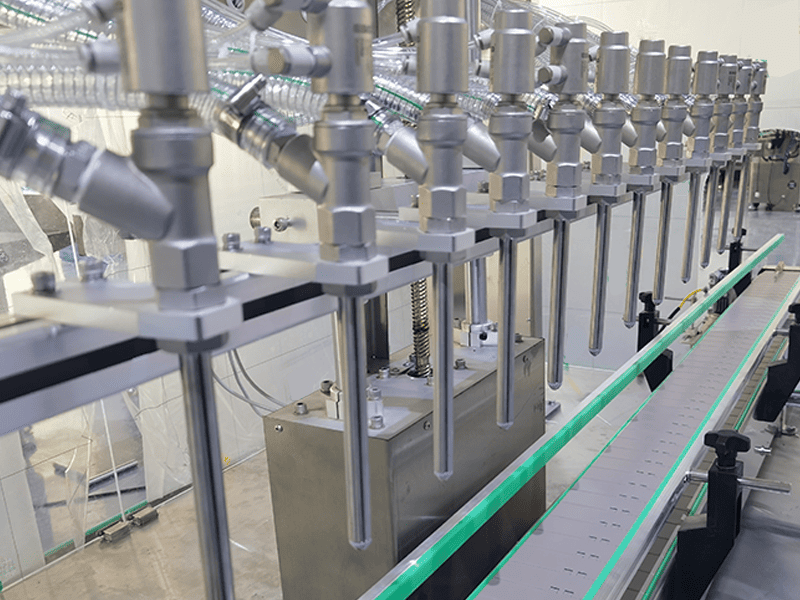Mastering Overflow Filling Machine: The Science of Perfect Liquid Levels
Overflow Filling Machine Built for Precision and Consistency in Demanding Industries
The Gravity Advantage: Core Operating Principle
Unlike pressure-dependent systems, an Overflow Filling Machine leverages fluid dynamics through a simple principle.
Liquid self-levels to equilibrium points
Operation relies on three gravity-powered stages:
-
Initial rapid-fill phase
-
Subsequent transition to precision flow
-
Final level stabilization through overflow recirculation
Crucially, this method achieves identical fill heights – not volumes – across containers.

Step-by-Step Workflow Breakdown
Phase 1: Container Engagement & High-Speed Filling
First, pneumatic clamps elevate containers against nozzle seals. This action creates critical airtight isolation. Simultaneously:
-
Main valves open fully
-
Product floods containers at 15-20 LPM flow rates
-
Visual indicator: Turbulent flow in sight glasses
Phase 2: Precision Transition Control
As levels approach 90% capacity:
-
Transition valves restrict flow by 70-80%
-
Consequently, splashing/foaming risks drop by 40%
-
Meanwhile, overflow ports activate at preset heights
Importantly, recirculation lines return excess product to reservoirs.
Phase 3: Equilibrium Confirmation & System Reset
During stabilization:
-
Liquid levels equalize across all nozzles
-
Result: Consistent fills despite container volume tolerances
-
Finally, vacuum systems purge return lines
Engineering Excellence: Accuracy Assurance Systems
(ISO 9001:2015 Certified Components)
| Component | Critical Function | Performance Metric |
|---|---|---|
| Dual-Stage Valves | Flow rate modulation | Response time <0.3s |
| Laminar Flow Nozzles | Turbulence elimination | Fill deviation ±0.3mm |
| Laser-Level Sensors | Height verification | OIML R 61 Compliance |
Pro Tip: For carbonated beverages, pressurized chambers maintain 1.5-2 bar CO₂ levels during filling cycles.
Industry-Specific Applications
Cosmetic & Pharma Advantages
Specifically:
-
Perfumes: Recirculation prevents alcohol evaporation
-
Moreover, anti-drip nozzles eliminate product tailing on luxury creams
Chemical Handling Solutions
Notably:
-
Conductive nozzles prevent static discharge
-
Additionally, PTFE-lined pathways resist corrosive agents
Competitive Technology Comparison
| Parameter | Overflow Filler | Piston Filler | Peristaltic |
|---|---|---|---|
| Accuracy | ±0.1% (height) | ±0.5% (vol) | ±2.0% |
| Speed | Up to 150 BPM | 100 BPM | 40 BPM |
| Particulate | Max 1/3 nozzle Ø | Unlimited | Limited |
However, overflow systems outperform alternatives in foam-sensitive applications.
Maintenance Protocol Enhancements
Daily Critical Checks
Begin with overflow channel inspections for crystallization. Next, verify:
-
Vacuum pressure ≥0.7 bar
-
Nozzle alignment tolerance <0.5mm
Monthly Performance Preservation
-
First, ultrasonic-clean all fluid paths
-
Then, recalibrate sensors with NIST tools
-
Finally, test valve response curves
Troubleshooting Note: When fill variations exceed 0.5mm:
-
Immediately inspect nozzle seals
-
Concurrently check reservoir vents
Customization for Modern Production
*(GB/T 19146-2010 Compliant)*
Available configurations include:
-
Rotary nozzle arrays for irregular containers
-
Complementary CIP/SIP integration
-
Advanced MES connectivity packages
Explore Precision Solutions:
[► Download Overflow Filler Engineering Specification Kit]

